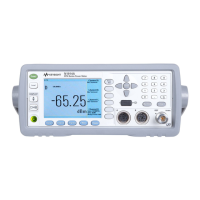Page 15
Find us at www.keysight.com
E-Series CW Power Sensor Specifications (Continued)
Power linearity
Table 6. E4410 Series power linearity specification.
Power Temperature (25 ± 5 °C) Temperature (0 to 55 °C)
100 pW to 10 mW (–70 to +10 dBm) ± 3% ± 7%
10 mW to 100 mW (+10 to +20 dBm) ± 4.5% ± 10%
+20
+10
+6
–20
–35
–70
± 4%
+3%
A
B
–70 –35 –20 –10 +10 +20
Power level used as reference (dBm)
Power level being measured (dBm)
Figure 1� Relative mode power measurement linearity with EPM Series power
meter/E-Series CW power sensor at 25 °C ± 5 °C (typical)�
The chart in Figure 1 shows the typical
uncertainty in making a relative power
measurement, using the same power
meter channel and the same power sensor
to obtain the reference and the measured
values� Example A illustrates a relative
gain (amplifier measurement)� Example
B illustrates a relative loss (insertion
loss measurement)� This chart assumes
negligible change in frequency and
mismatch occur when transitioning from
the power level used as the reference to
the power level being measured�
Example A
– P = 10(P)/10 x 1 mW
– P = 10 6/10 x 1 mW
– P = 3�98 mW
– 3%x3.98mW=119.4μW
Example B
– P = 10 (P)/10 x1 mW
– P = 10 –35/10 x 1 mW
– P = 316 nW
– 3% x 316 nW = 9�48 nW
where
– P = power in Watts
and
– (P) = power in dBm
Mechanical characteristic
Mechanical characteristics such as center
conductor protrusion and pin depth are
not performance specifications� They
are, however, important supplemental
characteristics related to electrical
performance� At no time should the pin
depth of the connector be protruding�

